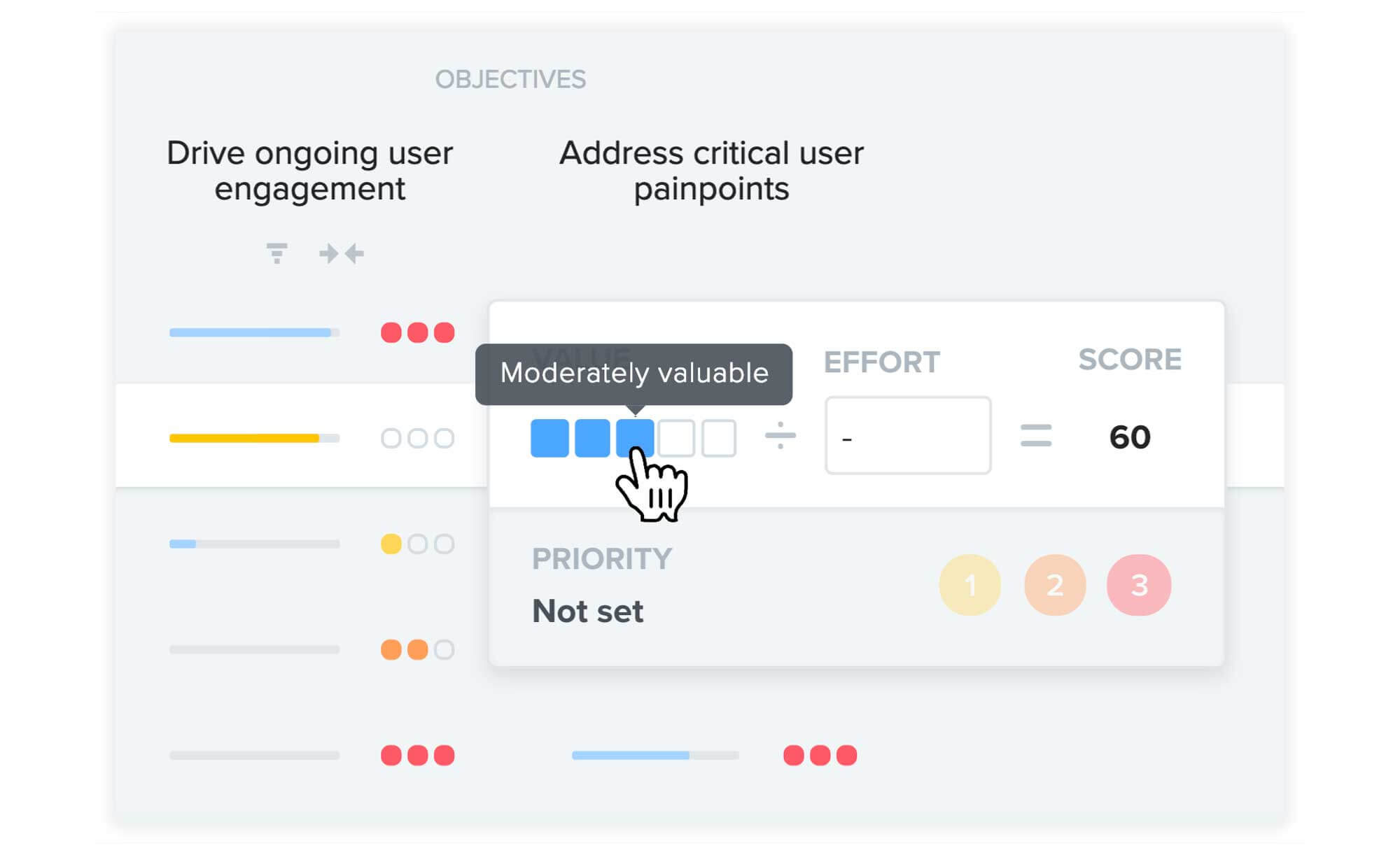Your biggest product manager responsibilities are not the ones you think

Top Priorites for Product Management
Product management as a whole is currently evolving, and many companies are still trying to clearly define the role in their organizations. In the past, PMs were often primarily responsible for technical and project management duties as strategic decisions about the product were led by sales or engineering. However, as companies begin to compete on product experience, product managers are leading strategy, and it’s their primary goal is to decide what to build next.
However, to make the best decisions about what to build next and how to effectively align your company around those decisions, you’ll need to go beyond understanding technical issues or managing scope creep. Key responsibilities that you need to focus on include drawing out customer insights, learning about customer behavior through experimentation, defining strategy and long-term success, and inspiring non-product teams.
1. Drawing out user insights
Great product managers know the importance of getting feedback from users. They’ll listen and make a genuine effort to build features that solve problems. Great product managers, however, will go the extra mile to draw out deep user insights to uncover actual needs and pain points.
Surface-level feedback doesn’t always give you actionable information that helps make your product better. When a user tells you a certain feature within your product isn’t working correctly, it can be a sign of one or more problems, such as:
- The feature is improperly designed.
- The feature is fine, but it isn’t intended for the customer’s use case.
- The feature is fine, but the customer doesn’t have the necessary information to use it properly.
If you just start building a fix—or a new feature entirely—without learning more, you won’t know which of the above is true. And that means there’s a good chance you’ll build the wrong thing.
The first step towards effectively drawing out user insights is to organize everything into a single location.

User insights come into your business from multiple different channels and to multiple different teams. Support tickets, email, Slack conversations, comments on social media channels, and sales notes all contain valuable customer insights. However, without a single repository for all information, it’s easy to miss or overlook a lot of them.
The second piece of the puzzle is learning to interview your customers.
Users rarely express the root cause of their problem when they first give you feedback. It takes multiple questions to drill down into an experience and find the true source of a particular pain point. An interviewing framework, such as the ‘five whys’ technique, helps you and all your customer-facing teams get to the root cause of a customer issue or complaint.
2. Learning about customer behavior through experimentation
Moving straight from insights into rolling out a feature can be a dangerous game. You can design a feature 10 different ways to solve the same problem, but your users will interact with some designs better than others. The most logical solution to a problem won’t always be the one customers adopt, and the best way to figure out which ones work is to experiment. That’s why you still need to understand user behavior when conceiving of possible solutions.
Kristen Berman, co-founder of Irrational Labs, talks about “Behavioral Product Managers” who mix data and psychology and says, “A bad BPM builds for a persona or the ideal customer behavior rather than the actual user behavior…A good BPM understands that humans have systematic irrationalities. They seek to understand these irrationalities and build for them.” There’s a difference between ideal customer behavior and actual customer behavior.
That’s why it’s important to experiment with prototypes to figure out the best way to align specific features with customer behavior. Using prototypes increases your chances of finding a solution or design that works well. In instances where you’re still unsure about the root cause of a user’s issue, a low fidelity prototype, with nothing but the bare functionality mapped out, can help further clarify and diagnose the problem you are trying to solve. Furthermore, because these prototypes require such little commitment, you’ll have more flexibility to test a range of ideas and designs and thus have a better chance of finding the right solution.

Prototypes can range in style and complexity from paper drawings showing what screens appear when you press certain buttons to semi-functioning interactive digital interfaces. With a paper wireframe, you can show how a feature will work to users and get instant feedback on your idea. To iron out some of the finer details though, consider using a digital prototyping tool like Keynote, InVision, and Axure. These apps let you design interfaces that users can actually click through. Instead of just explaining and talking through a new feature, you can observe a customer using it before you build it.
3. Defining strategy and long-term success
Your day-to-day activities as a product manager will, for the most part, be focused around specific features and measuring the success of those features. However, what makes a great product manager isn’t just ensuring that all the features your team builds perform well on their own, but that they guide the product towards a long-term goal or vision. That’s why one of the most essential and overlooked PM responsibilities is defining long-term success for the product you manage.
Getting caught in a reactive mindset is all too easy. John Cutler put it best when he said, “While everyone talks about ‘outcomes over output’ and says they strive for ‘real impact’ with their craft, in our day-to-day work, many of us simply give all our priorities and attention to shipping features.”
There is always a fire that needs to be put out and always a feature that needs to get out the door quickly. When you jump from fire to fire and feature to feature, however, you lose sight of what is most important—your overall product vision. Instead of building a product that purposely aligns itself to specific goals and initiatives, you’ll end up with a smattering of features that solve problems here and there but don’t work together to drive business goals.
To avoid getting sucked into this mindset, it’s important first to define the larger objectives of your product, and, secondly, to visualize and map out how the features you build will support those objectives.

Defining your products’ objectives requires collaborating with company leadership and department heads to agree on what the company’s goals and priorities are for the next quarter or year. The objectives for the product should align with and support these goals.
Objectives can’t just be lofty statements that you write down somewhere and don’t think about again. To make sure you are making progress towards your objectives, organize every feature request and every upcoming feature based on the objective it supports. By mapping out the relationship between the features you work with day-to-day and the big picture goals you have for your product, you’ll be able to stay focused and resist the pull of building feature after feature without a unified sense of direction.
4. Inspiring non-product teams across the company
If the product team is the only team that’s excited about the features they’re building, then even the most flawlessly crafted product strategy will fail. The success of the product instead relies on a combined effort from engineering, design, marketing, sales, and customer success teams.
However, as a product manager, you don’t have authority over all those departments, so you need to hone your persuasive abilities to inspire them. In writing about this dilemma, Marty Cagan says, “the product manager quickly finds that there are many decisions that she does not own, but which impact her product. For these, she must use her persuasive skills.” Sachin Rekhi also believes that ‘influencing without authority’ is one of the most important product manager responsibilities.
The key to getting everyone on the same page lies in the principles of human motivation. Daniel Pink, the author of Drive: The Surprising Truth About What Motivates Us, describes the three main drivers for motivation are autonomy, mastery, and purpose. Being a persuasive product manager, then, boils down to getting everyone in your company to take pride in their contributions to the product and value the vision you have for it, even though it might not match what they want from it.
Consider sharing your product roadmap, so internal stakeholders can see how a feature fits into the larger picture. A sales team will be much more likely to contribute towards the successful launch of a feature that doesn’t immediately benefit their sales goals if they can see that it’s part of a larger plan that, in the end, will drive long term sales goals.





